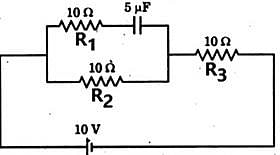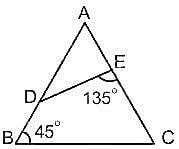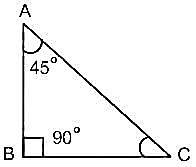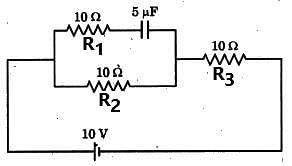MP Police SI (Technical) Mock Test - 3 - MP Police SI MCQ
30 Questions MCQ Test MP Police SI Mock Test Series 2025 - MP Police SI (Technical) Mock Test - 3
| 1 Crore+ students have signed up on EduRev. Have you? Download the App |
A solution which is  each in
each in  and
and  is treated with
is treated with  sulphide ion. If
sulphide ion. If  of
of  and
and  are
are  and
and  respectively, which one will precipitate first?
respectively, which one will precipitate first?
 each in
each in  and
and  is treated with
is treated with  sulphide ion. If
sulphide ion. If  of
of  and
and  are
are  and
and  respectively, which one will precipitate first?
respectively, which one will precipitate first?Direction: In the question below consists of a question and two statements numbered I and II given below it. You have to decide whether the data provided in the statements are sufficient to answer the question. Read both the statements and give answer:
What is the area of a right-angled triangle ABC, right angled at A?
Statement I : The circum radius of the triangle is 6 cm.
Statement II : Angle ABC = 60 degrees
In Δ ABC, ∠B = 90° and ∠A = 45°. If the length of its hypotenuse is 8 units, then the length of any other side (in units) is:
The circumference of the base of a cylindrical vessel is  cm and its height is
cm and its height is  cm. The capacity (in litres) of the vessel is:
cm. The capacity (in litres) of the vessel is:  Take
Take 
A ball of mass 2 kg is thrown up with a speed of 10 m/s. find the potential energy of the ball at the highest point?
Calculate molality of  of ethanoic acid
of ethanoic acid  in
in  of benzene.
of benzene.
Which, among the following qualities, is not affected by the magnetic field?
A cricket ball of mass  travelling at a speed of
travelling at a speed of  is caught by a fielder and in doing so he withdraws his hands back through
is caught by a fielder and in doing so he withdraws his hands back through  Calculate the work done by him.
Calculate the work done by him.
The kinetic energy of a particle having mass  is
is  . Its momentum will be:
. Its momentum will be:
A train crosses a bridge in 40 seconds and a pole in 25 seconds. If the speed of the train is 72 km per hour, then what will be the length of the bridge?
What is the highest common factor of  and
and  ?
?
Which of the following statements is correct for fibres?
What is boiling point of water in Fahrenheit?
Sonam covers 490 km in a boat in 35 hours against the stream and she take 14 hours with the stream then find the speed of the stream?
An electrical circuit having combinations of resistances and capacitance is given below. The current, flowing through the circuit will be:

A wagon weighing  kg is moving with a velocity
kg is moving with a velocity  km/h on smooth horizontal rails. A mass of
km/h on smooth horizontal rails. A mass of  kg is dropped into it. The velocity with which it moves now is:
kg is dropped into it. The velocity with which it moves now is:

For the above balanced equation  and
and  are respectively:
are respectively:
Which of the following is not a function of the magnetic frame in a DC generator?
In the following figure AD = 5 cm, AB = 12 cm and AE = 6 cm, then find length of AC?

Which of the following material cannot be used to make a lens?
Which of the following lenses will bend the light rays through least angle?
Product of Force and Velocity is called ______.
Which of the following phenomenon is the basis of an electric generator?


 of
of  is:
is: of
of 
 of
of 
 of
of 






 The value of
The value of  of
of  is
is  .
. the metal sulphide having the lowest solubility will precipitate first provided the ionic product is higher than the
the metal sulphide having the lowest solubility will precipitate first provided the ionic product is higher than the  . Here, all salts are of the same valence type. So, the sulphide having the lowest
. Here, all salts are of the same valence type. So, the sulphide having the lowest  value will precipitate first provided
value will precipitate first provided  has the lowest
has the lowest  value
value  , so it will precipitate first.
, so it will precipitate first.

 .
. cm and its height is
cm and its height is  cm.
cm.
 liter
liter  cm
cm
 and
and  respectively.
respectively. cm
cm
 cm
cm cm (Given}
cm (Given}

 cm
cm
 liter
liter liter
liter The volume of the cylindricla vessel
The volume of the cylindricla vessel  liter.
liter. mv2
mv2








 i.e., s = 40cm = 0.4 m
i.e., s = 40cm = 0.4 m

 ....(i)
....(i)





 .
.


 (momentum)
(momentum) 

 and
and 




 and
and  .
. .
. is boiling point of water in Fahrenheit.
is boiling point of water in Fahrenheit. that is equal to
that is equal to  .
. .
.
 to give chloro carbene:
to give chloro carbene:  .
. are eliminated to give the isocyanide.
are eliminated to give the isocyanide. is
is  .
.



 and the capacitor
and the capacitor  will be nullified and the current flows as it is in the wire.
will be nullified and the current flows as it is in the wire.
 voltage
voltage current
current resistance
resistance










 is dropped into it.
is dropped into it.
 is the velocity of the system.
is the velocity of the system.





 and e for the reaction
and e for the reaction  are 1,5,3,4 respectively.
are 1,5,3,4 respectively.

 HCF
HCF 





 , then the value of
, then the value of  is:
is:











 required answer is
required answer is  .
.














